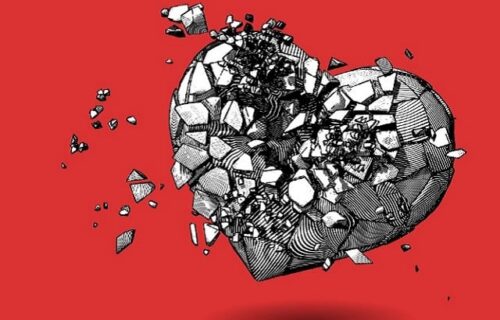Love and heartbreak are integral parts of the human experience, capable of uplifting us to the highest of highs or plunging us into the depths of despair. While poets and songwriters have long romanticized the concept of a “broken heart,” science is now shedding light on the profound impact that heartbreak can have on both our physical and emotional well-being.
When we fall in love, our bodies undergo a series of enchanting changes, flooding us with feel-good hormones and bonding chemicals. However, when love is lost, the same chemicals that once made us euphoric can quickly turn into agents of anguish and distress. The aftermath of a breakup can often leave us feeling emotionally shattered, but what is lesser-known is the tangible effect it has on our bodies.
In this article, we delve into the scientific insights behind the experience of a broken heart. Drawing from recent research and expert perspectives, we will explore the intricate interplay between our minds and bodies during times of heartache.
From the immediate physiological reactions to the potential long-term health implications, understanding the profound impact of heartbreak could offer solace and guidance for those navigating through the storm of a broken heart. So, brace yourself for a captivating journey into the realm where love, pain, and science converge, as we uncover what truly happens to your body when you have a broken heart.
The Psychological Impact: What Does A Broken Heart Do To Your Body
When someone experiences a broken heart, the body undergoes a complex array of physiological responses that are driven by both emotional and biochemical factors. The term “Broken Heart Syndrome” or Takotsubo cardiomyopathy encompasses the unique physiological changes that occur in response to severe emotional stress, leading to temporary weakening of the heart muscles. Let’s delve into the scientific intricacies of what happens to the body during this challenging period:
1. Stress Response Activation:
Emotional distress triggers the body’s stress response, commonly known as the “fight or flight” response. When confronted with intense emotional turmoil, the brain signals the release of stress hormones, including adrenaline and cortisol. These hormones prepare the body for immediate action, leading to a rise in heart rate, increased blood pressure, and a surge in energy to cope with the perceived threat or distress.
2. Impact on the Heart:
The surge of stress hormones and the activation of the autonomic nervous system during intense emotional stress can directly affect the heart. The release of adrenaline can cause vasoconstriction, narrowing the blood vessels and increasing blood pressure. Elevated blood pressure, in turn, increases the workload on the heart.
3. Blood Flow Alterations:
The impact of stress hormones on blood vessels can also lead to impaired blood flow to certain areas of the heart. This can result in reduced oxygen supply to the heart muscles, leading to chest pain or angina-like symptoms.
4. “Ballooning” Effect:
The most distinctive feature of Broken Heart Syndrome is the “ballooning” effect that occurs in the left ventricle of the heart. The intense emotional stress causes the left ventricle to temporarily weaken and enlarge, resembling the shape of a Japanese octopus trap called a “tako-tsubo.” This abnormal shape affects the heart’s ability to pump blood effectively.
5. Heart Rhythm Abnormalities:
The disruptions caused by the surge in stress hormones and the “ballooning” effect can lead to heart rhythm abnormalities, known as arrhythmias. These irregular heartbeats can manifest as palpitations, skipped beats, or a fluttering sensation in the chest.
6. Symptoms Resembling a Heart Attack:
Given the similarities in symptoms, Broken Heart Syndrome is often mistaken for a heart attack. Both conditions can lead to chest pain, shortness of breath, and nausea. However, unlike a heart attack, Broken Heart Syndrome does not involve the blockage of coronary arteries.
7. Rapid Onset and Reversibility:
One distinguishing characteristic of Broken Heart Syndrome is its rapid onset and reversible nature. Unlike a heart attack, which causes lasting damage to the heart muscle, Broken Heart Syndrome typically resolves within days to weeks, with the heart returning to its normal function.
8. Gender and Age Differences:
Studies have shown that women, especially those who are post-menopausal, are more susceptible to Broken Heart Syndrome than men. The exact reasons for this gender difference are still being studied, but hormonal factors and differences in stress responses between men and women may play a role. Additionally, the risk of Broken Heart Syndrome increases with age, and individuals between 58 and 75 years old are most vulnerable.
Healing from Heartbreak: The Power of Resilience
Despite the overwhelming emotional and physical toll of heartbreak, humans have an incredible capacity for resilience. Just as the heart can experience brokenness, it can also undergo healing and restoration. Numerous studies have shown that resilience plays a crucial role in recovery from emotional trauma.
Resilience is the ability to bounce back from adversity, and it can be nurtured through various means. Engaging in practices that promote self-compassion, self-care, and positive coping strategies can aid in the healing process. These practices may include therapy, journaling, connecting with nature, or participating in support groups. By acknowledging the pain and actively working through it, individuals can gradually rebuild emotional strength and regain a sense of balance.
The Role of Social Support: A Lifeline in Times of Turmoil
During times of heartbreak, social support can be an invaluable lifeline. Turning to friends, family, or support groups can offer a sense of belonging and understanding, easing the burden of emotional distress. Social connections have been shown to buffer the negative effects of stress, providing emotional comfort and fostering a sense of hope.
Additionally, strong social networks can encourage healthier lifestyle choices, such as regular exercise and a balanced diet, both of which play a role in maintaining heart health. When navigating the aftermath of heartbreak, the embrace of a supportive community can make a significant difference in an individual’s journey to healing.
Lessons From A Broken Heart: Personal Growth and Transformation
While heartbreak is an incredibly challenging experience, it can also be an opportunity for profound personal growth and transformation. Through introspection and self-discovery, individuals may gain insights into their emotions, desires, and values. This period of self-reflection can pave the way for increased self-awareness and a deeper understanding of what one truly seeks in life and relationships.
For some, heartbreak may serve as a catalyst for positive change, motivating them to reassess priorities, set new goals, and embark on new adventures. It is through these transformative moments that individuals can emerge stronger, more compassionate, and better equipped to navigate future challenges.
Conclusion: The Pain Of A Broken Heart Doesn’t Last Forever
The journey through heartbreak may be fraught with pain, uncertainty, and vulnerability, but it also illuminates the profound resilience of the human heart. As science unravels the intricacies of Broken Heart Syndrome, we gain deeper insights into the physical manifestations of emotional trauma. However, it is the interconnectedness of our emotional and physical selves that reminds us of the significance of holistic well-being.
From the depths of despair to the heights of recovery and transformation, the human heart proves its capacity to endure, mend, and love again. Whether through the embrace of social support, the cultivation of resilience, or the exploration of personal growth, the journey from heartbreak to healing is a testament to the enduring strength of the heart—both figuratively and literally. Let us embrace our vulnerabilities and triumphs, for they are woven into the rich tapestry of the human experience.
In conclusion, the experience of a broken heart is not merely a metaphorical expression of emotional pain. Scientifically, it involves a series of intricate physiological responses triggered by intense emotional stress. The temporary weakening of the heart muscles, the changes in blood flow, and the heart rhythm abnormalities all underscore the tangible connection between our emotional and physical selves. As science continues to unravel the complexities of Broken Heart Syndrome, we gain a deeper appreciation for the profound impact of emotional distress on our bodies and the importance of holistic well-being in navigating through the challenging terrain of heartbreak.





